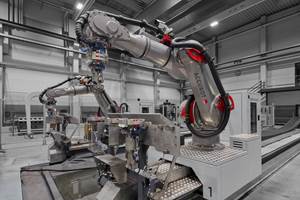FACC achieves 10.6% revenue growth in H1 2025 amid aerospace supply chain challenges
Revenue was increased to €484.7 million and a positive €18.4 million EBIT maintained, driven by strong business jet demand, global expansion of FACC’s production network and early results from its efficiency program.
Winglet production. Source | FACC Bartsch
In the first half of 2025, (Ried im Innkreis, Austria) reports it was able to achieve a 10.6% increase in revenue to €484.7 million (same period in 2024: €438.3 million) despite a still challenging global environment.
All divisions of FACC (Aerostructures, Cabin Interiors, and Engines and Nacelles) reported a positive EBIT in the first half of 2025. Group EBIT of €18.4 million is in line with management's expectations and is burdened by disruptions in international supply chains as well as high material and personnel costs (same period in 2024: €22.5 million). Compared to the previous year, the number of employees increased by 123 employees (FTE).
Overall, growth of the aviation industry continued in the first half of the year. While short-term adjustments took place in the market for passenger aircraft — which were affected by supply chain problems in the engine sector — FACC was able to benefit from the sustained positive development of the business jet market in part due to the company’s diverse product strategy. The long-term growth of the whole industry is illustrated by a worldwide record order backlog of more than 17,500 passenger aircraft ordered. This is also reflected in FACC’s order backlog, which rose to more than $6 billion in the first half of 2025 with new orders and rate increases.
FACC’s global production and sales network of 15 international locations in Europe, the U.S. and Asia provides it with a high level of resilience given the current geopolitical challenges. With the strengthening of the supply chain in India, relocation of production of the COMAC C919 product range (structural and interior systems) to China, and an increase in operating performance at the FACC plants in Croatia/Jakovlje and in Canada/Montreal, this location strategy could be further advanced in the first half of 2025.
The company’s cost reduction and efficiency program, which has been in place since October 2024, is already showing results. This is illustrated by FACC’s increase in revenue with around the same number of employees since the end of FACC’s 2024 financial year. In addition, the focus in the first half of 2025 was on optimizing the supply chain and reducing material inventories. These have been significantly reduced since the end of Q3 2024, thereby contributing to an improvement in cash flow.
When considering its outlook for the duration of 2025, FACC expects to see around 5 billion passengers in the aerospace industry for the first time. Airlines’ demand for efficient and modern aircraft remains high, and despite ongoing supply chain challenges, all major aircraft manufacturers are confirming their targets for the entire 2025 financial year at the end of the first half of the year.
Based on the current market situation for 2025, FACC management expects growth to continue and has specified its outlook at the half-year mark at around €1 billion in group revenue, which corresponds to a revenue growth of more than 10% compared to the previous year. The EBIT margin will continue to improve compared to 2024 due to effects from FACC’s efficiency improvement program currently being implemented (2024: 3.2%).
Related Content
Automated robotic NDT enhances capabilities for composites
Kineco Kaman Composites India uses a bespoke Fill Accubot ultrasonic testing system to boost inspection efficiency and productivity.
Read MoreOtto Aviation launches Phantom 3500 business jet with all-composite airframe from Leonardo
Promising 60% less fuel burn and 90% less emissions using SAF, the super-laminar flow design with windowless fuselage will be built using RTM in Florida facility with certification slated for 2030.
Read MorePlant tour: Aernnova Composites, Toledo and Illescas, Spain
RTM and ATL/AFP high-rate production sites feature this composites and engineering leader’s continued push for excellence and innovation for future airframes.
Read MoreDevelopment of a composite liquid hydrogen tank for commercial aircraft
Netherlands consortium advances cryogenic composites testing, tank designs and manufacturing including AFP, hybrid winding, welding of tank components and integrated SHM and H2 sensors for demonstrators in 2025.
Read MoreRead Next
FACC optimizes inspection processes through augmented reality
Cooperation with students from the University of Applied Sciences Upper Austria leads to successful use of AR, increasing the efficiency of components testing.
Read MoreFACC agreements with Rolls-Royce, Tata and Kineco expand its global backlog, footprint in India
The composites aerostructures supplier extends supply contract with Rolls-Royce and establishes new cooperations with Tata Advanced Systems Ltd. and Kineco Aerospace in India.
Read MoreAirbus full year 2024 financial results highlight strong business
Despite the challenge year, Airbus attained its 2024 outlook, with solid order intake across all businesses and €69.2 billion in revenue.
Read More












